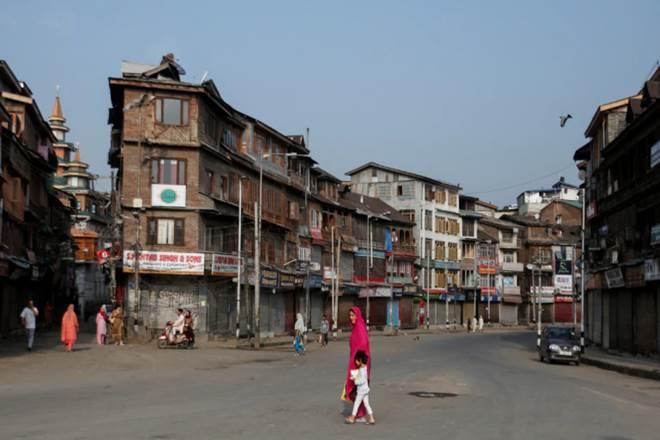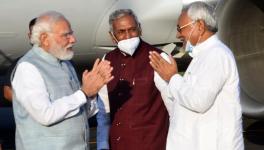One Month of Clampdown: Has Normalcy Returned to Kashmir at All?

Image for representational purpose only. Courtesy: Financial Express
Srinagar: A month has passed since the government enforced a massive clampdown in Jammu and Kashmir and unilaterally abrogated Article 370 that ensured a somewhat semi-autonomy for the people of the region. Even as the government claims it has ended restrictions in most parts now, people say, they are caught up in limbo with anxiety growing each passing day.
Sending shockwaves across the region, on August 4, the government began its crackdown on politicians, lawyers, businessmen, political activists and many others as a measure to prevent any law and order situation, charges many considered as ‘flimsy’.
“The restriction during day time has been lifted from 92 police stations which means 90% of the Valley is free of any sort of restrictions. Jammu and Ladakh are free from such restrictions,” government spokesperson Rohit Kansal said.
The government has decided to open 26 more exchanges making the number of functional exchanges 76 out of 95. According to Kansal, over 26,000 landlines are functional in the Valley. The landlines include the communication lines in the government offices.
Despite the government stating that the situation is closer to normalcy, it is yet to end the communication blockade. The mobile networks and internet services continue to remain snapped, especially, in the Valley of Kashmir.
In several parts of Srinagar, especially the civil lines of Rajbagh, Jawahar Nagar, Hyderpora, Shivpora and Lal Chowk, the movement of private vehicles plying on the roads has increased due to easing of restrictions, but public transport is still off-roads. In rural areas as well, the movement of vehicles is restricted to central towns only.
Just a little outside these areas, however, things have not improved much. There is a shutdown also being observed by people simultaneously. The old city areas of Srinagar, which is a cluster of hundreds of localities housing hundreds of thousands of households, are mostly deserted with almost all shops shut with an exception of medical establishments. The shops and other business establishments like petrol pumps open in the morning and sometimes during late evening.
Also read: Kashmir: Why Amit Shah’s ‘Development’ Argument is a Hoax
In many of these areas, people have been urging others to observe shutdown as a ‘protest’. Locals in many areas claim, sometimes posters appear on the walls outside calling for a shutdown. “We have seen these posters on many days, but then they also disappear and then reappear again. I think the security forces remove them and people paste them again,” a resident of Habba Kadal said.
Just like old city neighborhood, many urbanised areas like Lal Bazar, Soura, Natipora, Bemina, HMT, Chanapora have not returned to any visible state of normalcy. Similarly, in rural areas, there are no signs of any significant improvement.
“There is movement on the national highway, but towards the rural interiors, things have not changed just like everywhere and people are observing the shutdown,” Bashir Ahmad, a resident of South Kashmir told NewsClick.
In areas of South Kashmir like Heff Sheermaal, Karimabad, Quhil and in the North Kashmir’s Lawaypora, Kunzer, Tangmarg, Pattan-Palhalan, Sopore, there have been sporadic incidents of violence as well.
“In the past incidents of unrest, there was always an end in sight, and we could sense it. This time, it looks like there will not be an end. We are caught up very bad,” Mohammad Ashraf, a resident of rural North, said. Ashraf, who is in his fifties, added, “We are back to the pre-90s era.”
What has amplified the state of unease among people is the lack of flow of information. Due to communication blockade, education, work and business have suffered a great deal.
In absence of mobile phones, internet, banking and the courier services, people usually book flights to New Delhi to get their work done. “Since the banks are closed in Kashmir, I went to Lajpat Nagar branch in Delhi to apply for an international use for my debit card,” a resident of Srinagar, Amir, said.
But not everyone is as lucky as Amir; many people can’t afford to travel.
A day ago, on September 3, online registrations opened for Graduate Aptitude Test for Engineering (GATE) exams, but there are no means to apply online, which has left the students perplexed. “I came to know about it in a newspaper that the exams are scheduled for February. I am not sure if I can apply this year now,” said Faisal, an aspirant from Srinagar.
Difficulties in everyday lives is one thing that indicates how far people in Kashmir are from living a normal life. For many, though, there is not much hope even after returning to normalcy. “It wouldn’t make much difference even if we return to routine lives. What then? We have incurred massive losses in the past month not just individually, but collectively as well. And apart from immediate effects, there will be long-term ones as well,” said a resident of Humhama from Srinagar outskirts.
Also read: It’s a Mockery of Democracy, Say Over 200 Writers, Cultural Activists on Kashmir Situation
Get the latest reports & analysis with people's perspective on Protests, movements & deep analytical videos, discussions of the current affairs in your Telegram app. Subscribe to NewsClick's Telegram channel & get Real-Time updates on stories, as they get published on our website.
























